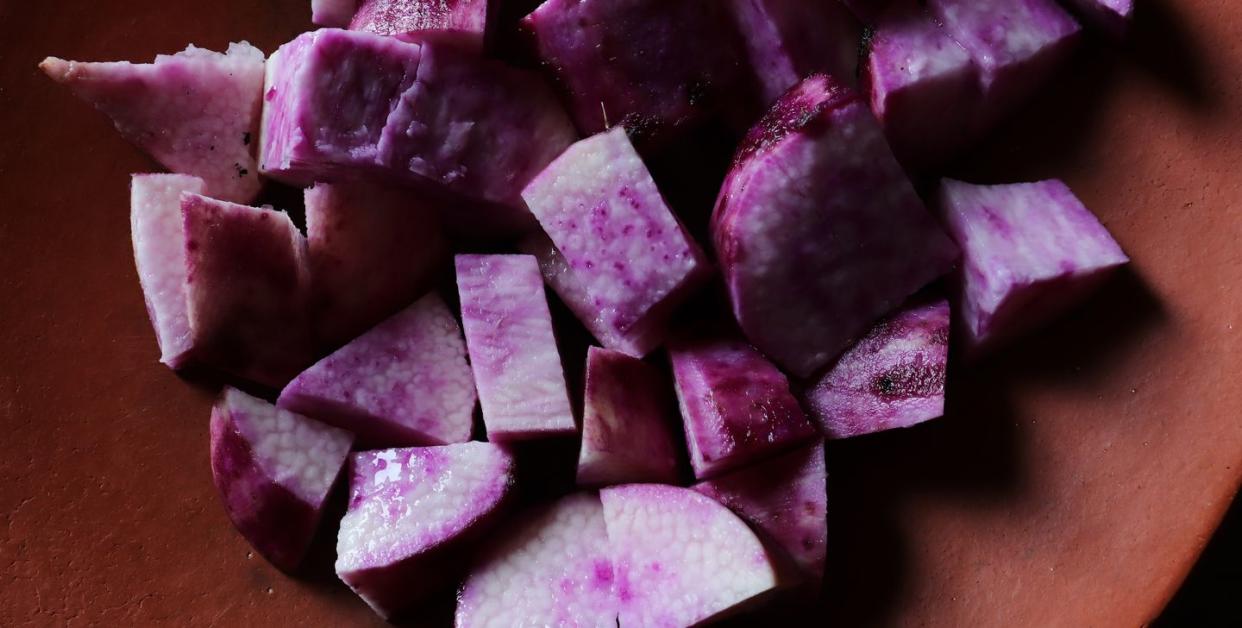What The Eff Is Ube Anyway & Why Are People So Obsessed With It?

Ube is known for its bright purple color. You've probably seen it in desserts like ice cream and cookies. But what exactly is ube? And what are the best ways to cook with it? We went to Amy Besa, owner of the Filipino restaurant Purple Yam in New York City and author of Memories of a Philippine Kitchen, to learn more about this ingredient and how to use it.
Jump to:
What Is Ube?
Where Does Ube Come From?
How To Use Ube
What Does Ube Taste Like?
Where To Buy Ube
What Is Ube?
Ube is a starchy root vegetable native to the Philippines. It's used in recipes more often than eaten on its own, so you may not be aware of what it actually looks like. Growing up in the Philippines, Besa said ube was often eaten in the form of a jam called halaya. This has made some people think that ube was the jam itself, rather than an ingredient.
Ube is the Tagalog word for purple yam, but don't confuse it with the nearly identical purple sweet potato, also called the Okinawa sweet potato, or taro. While ube and purple sweet potatoes are similar and can sometimes be used interchangeably, there are some differences. Ube grows above ground on vines; purple sweet potatoes are grown in the ground. Ube has a much starchier texture.
There are also several varieties of ube. For example, the sapiro variety is fragrant, with a light lavender color and smooth, creamy texture, according to Besa. The deep purple yam is another variety she uses, and it's coarse with a dark purple hue.
Where Does Ube Come From?
Ube is native to southeast Asia and is particularly prominent in the Philippines, where it's used in several traditional recipes from savory entrees to desserts.
How To Use Ube
While ube is used in both sweet and savory dishes, Besa said that it's primarily used in sweet recipes. Ube halaya, or ube jam, is often used in desserts like halo-halo (Filipino shaved ice) or added to pies and ice cream, which you can often find at Purple Yam. Besa's husband, Romy Dorotan, who's also the restaurant's chef, adds ube powder to lumpia (spring rolls) and pandesal (traditional Filipino rolls). You can also find ube incorporated into dishes like ginataang, a pudding-like mixture made with coconut milk. Ube is also mashed and added to bilo-bilo, which are sweet mochi-like balls.
What Does Ube Taste Like?
Ube has a slightly sweet and nutty flavor. "Many people mistake the flavor of ube with the flavors they get from the jam," said Besa. "The ube is a starch so it's more of a neutral flavor." In the U.S., we often only have access to frozen ube, which she said often lacks flavor and aroma compared to fresh ube.
Where To Buy Ube
"If you really want to know what the flavor of ube is, then you really have to get it fresh and whole," said Besa. But fresh ube can be difficult to find in the U.S. Frozen ube, however can be found in some stores, especially Asian supermarkets.
You Might Also Like






